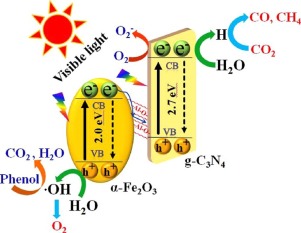当前位置:
X-MOL 学术
›
Appl. Catal. B Environ. Energy
›
论文详情
Our official English website, www.x-mol.net, welcomes your
feedback! (Note: you will need to create a separate account there.)
Exceptional photocatalytic activities for CO2 conversion on Al-O bridged g-C3N4/α-Fe2O3 Z-scheme nanocomposites and mechanism insight with isotopes
Applied Catalysis B: Environment and Energy ( IF 20.2 ) Pub Date : 2017-09-19 , DOI: 10.1016/j.apcatb.2017.09.042 Jinshuang Wang , Chuanli Qin , Hongjian Wang , Mingna Chu , Amir Zada , Xuliang Zhang , Jiadong Li , Fazal Raziq , Yang Qu , Liqiang Jing
Applied Catalysis B: Environment and Energy ( IF 20.2 ) Pub Date : 2017-09-19 , DOI: 10.1016/j.apcatb.2017.09.042 Jinshuang Wang , Chuanli Qin , Hongjian Wang , Mingna Chu , Amir Zada , Xuliang Zhang , Jiadong Li , Fazal Raziq , Yang Qu , Liqiang Jing

|
It’s highly desired to design and fabricate effective Z-scheme photocatalysts by promoting the charge transfer and separation. Herein, we firstly fabricated the ratio-optimized g-C3N4/α-Fe2O3 nanocomposites by adjusting the mass ratio between two components through a simple wet-chemical process. The resulting nanocomposites display much high photocatalytic activities for CO2 conversion and phenol degradation compared to bare α-Fe2O3 and g-C3N4. Noteworthily, the photocatalytic activities are further improved by constructing Al-O bridges, by 4-time enhancement compared to those of α-Fe2O3. Based on the steady-state surface photovoltage spectra, transient-state surface photovoltage responses, photoelectrochemical I-t curves and the evaluation of produced OH amounts, the exceptional photoactivities of Al-O bridged g-C3N4/α-Fe2O3 nanocomposites are attributed to the significantly promoted charge transfer and separation by constructing the g-C3N4/α-Fe2O3 heterojunction and the Al-O bridges. Moreover, the charge transfer and separation of this photocatalyst have been confirmed to obey the Z-scheme mechanism, as supported by the single-wavelength photocurrent action spectra and single-wavelength photoactivities for CO2 conversion. Furthermore, the mechanism of the photocatalytic CO2 conversion has been elaborately elucidated through the electrochemical reduction and the photocatalytic experiments especially with isotope 13CO2 and D2O, that the produced H atoms as intermediate radicals would dominantly induce the conversion of CO2 to CO and CH4.
中文翻译:

对于CO特殊光催化活性2对Al-O转换桥接GC 3 Ñ 4 /的α-Fe 2 ö 3 Z-方案纳米复合材料和用同位素机构洞察
迫切需要通过促进电荷转移和分离来设计和制造有效的Z型光催化剂。在此,我们首先制造的比率优化GC 3 Ñ 4 /的α-Fe 2层ö 3通过一个简单的湿式化学处理调节两种组分的质量比的纳米复合材料。将得到的纳米复合材料显示CO得多高的光催化活性2相比裸的α-Fe的转化率和苯酚降解2 ö 3和GC 3 Ñ 4。Noteworthily,光催化活性被进一步通过构造的Al-O桥改善,由4-时间增强相比,这些的的α-Fe 2O 3。基于稳态表面光电压谱,瞬态表面光电压响应,光电化学It曲线及其产生的评价OH量的Al-O的特殊photoactivities桥接GC 3 Ñ 4 /的α-Fe 2 ö 3个纳米复合材料通过构建所述gC归因于显著促进电荷转移和分离3 Ñ 4 /的α-Fe 2 ö 3异质结和Al-O桥。而且,已经证实该光催化剂的电荷转移和分离遵循Z方案机理,这由用于CO 2转化的单波长光电流作用谱和单波长光活性所支持。此外,光催化CO 2的机理通过电化学还原和光催化实验,特别是对13 CO 2和D 2 O同位素的光催化实验,已经清楚地说明了这种转化,即作为中间基团产生的H原子将主要诱导CO 2转化为CO和CH 4。
更新日期:2017-09-19
中文翻译:

对于CO特殊光催化活性2对Al-O转换桥接GC 3 Ñ 4 /的α-Fe 2 ö 3 Z-方案纳米复合材料和用同位素机构洞察
迫切需要通过促进电荷转移和分离来设计和制造有效的Z型光催化剂。在此,我们首先制造的比率优化GC 3 Ñ 4 /的α-Fe 2层ö 3通过一个简单的湿式化学处理调节两种组分的质量比的纳米复合材料。将得到的纳米复合材料显示CO得多高的光催化活性2相比裸的α-Fe的转化率和苯酚降解2 ö 3和GC 3 Ñ 4。Noteworthily,光催化活性被进一步通过构造的Al-O桥改善,由4-时间增强相比,这些的的α-Fe 2O 3。基于稳态表面光电压谱,瞬态表面光电压响应,光电化学It曲线及其产生的评价OH量的Al-O的特殊photoactivities桥接GC 3 Ñ 4 /的α-Fe 2 ö 3个纳米复合材料通过构建所述gC归因于显著促进电荷转移和分离3 Ñ 4 /的α-Fe 2 ö 3异质结和Al-O桥。而且,已经证实该光催化剂的电荷转移和分离遵循Z方案机理,这由用于CO 2转化的单波长光电流作用谱和单波长光活性所支持。此外,光催化CO 2的机理通过电化学还原和光催化实验,特别是对13 CO 2和D 2 O同位素的光催化实验,已经清楚地说明了这种转化,即作为中间基团产生的H原子将主要诱导CO 2转化为CO和CH 4。











































 京公网安备 11010802027423号
京公网安备 11010802027423号